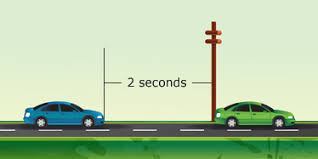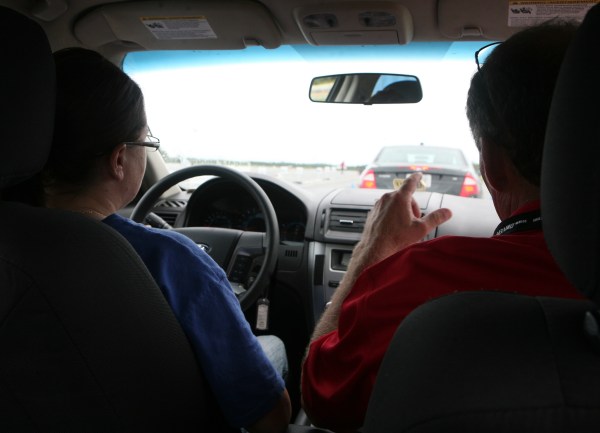Maintaining a safe distance is one of the fundamental factors of road safety, however it is not always easy to calculate how much space we need to leave between us and the vehicle in front, although there is a simple solution to a mathematical problem.

We will start with the science bit. There are the two main factors that influence how we are able to bring our vehicle to a safe stop. The first one is the reaction time, defined as “the time between the stimulation of a sensory organ and the start of a response or a reaction.” Applied to an emergency situation while driving, it is the time between we perceive a danger and act on the controls of the vehicle to avoid a collision.
The second factor is the braking distance, which, as its name indicates, is the distance it takes for our vehicle to stop completely from the moment we apply the brakes.
We will add in two points of reference here. Firstly, we will define the word, “hazard”, which in motoring terms is, “anything, actual or potential, which causes a vehicle to deviate speed, course or direction.”
The second point we will throw in here is that irrespective of maximum permitted speed limits on the road, we should always drive at such a speed which allows us to stop well within a distance we can see to be clear.
Now that we have those basic elements in mind, we will analyse a hypothetical situation in which we are driving on the motorway and the vehicle that precedes us abruptly stops.
Our natural reaction will be to step on the brake pedal as quickly and forcefully as possible to avoid the collision. The time that elapses between the perception of the danger, or hazard, and the moment we step on the brake pedal is the “reaction time”. During that time interval we will have travelled some distance before we actually started to reduce the speed of the vehicle.
Once we depress the brake pedal, the vehicle will still continue to travel forward, and will do so for a variable number of metres depending on the state of our brake equipment, the condition of the tyres, the suspension, and even the road condition, until we stop completely. This is the “braking distance”.
Although there are many different factors which determine the actual reaction time and braking distance, we can establish equations based on common elements. For example, in the hypothetical situation that we have just described, it is likely that the reaction time would be 0.75 seconds, assuming the driver is alert and in good physical and mental health. If we are tired or distracted, the reaction time is significantly affected. However, maintaining our 0.75 second principal reaction time, if we are on a motorway and travelling at 120 kilometres per hour, our vehicle would have travelled 25 metres before we depress the brake pedal.
The accurate braking distance is significantly more difficult to estimate, on account of the different parameters of each vehicle, road and environmental conditions, however we can generalise once again. A modern vehicle in good condition, on a good road in good weather will travel between 65 and 75 metres from a speed of 120 kilometres per hour.
In total, during our hypothetical situation, we travelled 25 metres and 70 metres during our respective reaction time and braking distance, and so 95 metres were covered from the moment we perceived the hazard and our vehicle coming to a stop. Therefore, it is crucial that we had a minimum of 100 metres distance between us and the vehicle in front to allow us to stop in time.
Again, we must stress the word, minimum. The more distance we have, the safer we will be. Remember these are optimum conditions we are talking about, but there are too many factors for it to be exact for every vehicle or situation. This, by the way, is the reason that distance marker chevrons are spaced at 100 metres apart on motorways. It is advisable to keep two chevrons apart from the vehicle in front, in other words, 200 metres, thus doubling our minimum safety distance.
We also mention the weather and environmental conditions. In wet weather the distance should always be at least doubled, although the roads are particularly hazardous during the first rain after a dry spell, so the more distance you can leave, the better.
We have discussed motorways, but the same equations apply on all roads. If we are travelling on an area of the conventional road network where the maximum permitted speed is 90 kilometres per hour, and the conditions allow us to do that safely, then we will have travelled 18.75 metres during the reaction time and the braking distance for a modern car in top condition would be 40 metres, and so we will have travelled almost 60 metres from the moment we noticed the hazard. Our minimum distance on these roads therefore should be 75 metres, although again it is better to double it to 150 metres.
On slower moving roads we should have at least 25 metres on roads where the maximum traffic flow is at 50 kilometres per hour, and 9 metres distance at 30 kilometres per hour.
So, now we have done the technical bit, we promised a simpler solution. You might remember the “two second rule” from your days of learning to drive. Well, the good news is that you can still use a variation of that concept.
Saying the phrase, “only a fool breaks the two second rule”, at a normal pace, even in your head, takes around 2 seconds. So, keeping an eye on the vehicle in front, watch as it passes a fixed point on the road, a sign, a shadow, a parked car, and say the phrase to yourself, or count if it´s easier. If you pass the same point before reaching the end of the sentence then you are too close, so back off. It is better if you can leave 3 or 4 seconds, repeating the phrase. In our motorway scenario above, the car would travel over 60 metres in 2 seconds, so you can see that it´s not enough.
Remember, the more distance you can allow, the safer you will be, as you are then more likely to be able to stop well within the distance you can see to be clear.






